Lockheed D-21B unmanned reconnaissance aircraft (US)
After the death of test operator Ray Torik, the chief designer of the D-21A project and Skunk Works head of the department, Kelly Johnson, ordered all flights to be stopped. The idea of a complex built on the principle of “mother and daughter” failed and led to tragedy. However, the supersonic high-altitude unmanned reconnaissance aircraft was still of interest to the potential customer, which is why a fundamental decision was made to continue the work, but already with the updating of the main features of the project. It was planned to increase the safety of the pilots during the project with the designation D-21B.
Tests of D-21A led to the identification of a number of design flaws that still needed to be addressed. At the same time, at the level of the concept and overall architecture, this project was recognized as suitable for further development. As part of the planned modernization it was possible to leave the existing drone, making minor modifications to its design. At the same time, it was necessary to radically reconsider views on the aircraft carrier, which is necessary for the initial acceleration and raising of the vehicle to the working height.
The use of a modified intelligence agent A-12 as a carrier did not justify itself. It was decided to use a different aircraft, namely the B-52H bomber. However, this machine differed subsonic flight speed and could not independently accelerate the UAV to the operating speeds of its engine. In this case, however, the long-range bomber could carry more than one reconnaissance vehicle. To solve the problem with the carrier's flight data, it was decided to develop an additional accelerator whose task would be to bring the D-21B to the required height and accelerate to the desired speed. The carrying capacity of the carrier bomber made it possible to lift both the drone itself and the apparatus with an accelerator into the air.
As a result, the appearance of the reconnaissance complex was determined as follows. The carrier was a serial bomber, the last necessary revision. It was proposed to hang the D-21B apparatus equipped with a booster accelerator. It was planned to take off from the airfield by the forces of a bomber, to which one or two vehicles were suspended. After climbing to a certain height and reaching a predetermined course, the plane had to drop its payload. Then the accelerator was switched on, which brought the device to the operating mode. After that, D-21B could be sent to its target and conduct reconnaissance. The last stage of the reconnaissance flight in the new project did not change: after the photography, it had to go to the specified area and reset the hardware compartment, after which the remaining units self-destructed. The container with the equipment was proposed to catch in the air with the help of Lockheed JC-130B Cat's-Whiskers aircraft with special equipment. It was also possible to lift the boarded container aboard a special vessel.
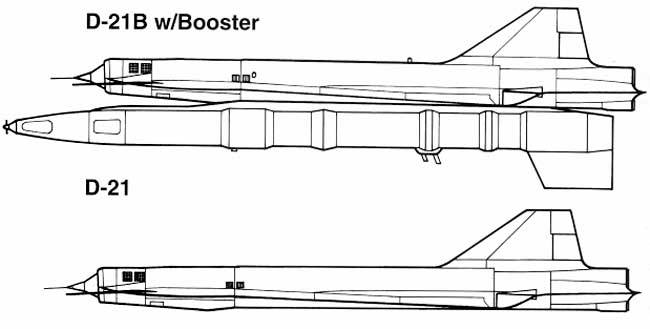
Scheme of the apparatus. From above D-21B with the accelerator, from below - without it. Figure Testpilot.ru
The proposed architecture of the complex D-21B allowed to do without serious alterations of the existing unmanned vehicle. The main features of its design remained the same, however, some changes were required for various units required for the installation of the accelerator and the suspension for a new carrier. The rest of the D-21B did not differ from the base D-21A.
The drone with reconnaissance equipment had a cylindrical fuselage with a frontal air intake, equipped with a conical central body. The tail end of the fuselage had a casing for the main engine nozzle. A triangular wing with developed ogival flux docked to the fuselage. There was a relatively large trapezoidal keel. To control the flight, it was proposed to use elevons, under which the entire rear edge of the wing was given, and the rudder on the keel. The length of the device was 13,1 m, wingspan - 5,8 m, height - 2,2 m. Take-off weight (excluding the accelerator) - 5 t.
The main structural elements of the D-21B apparatus were made of titanium. Only individual parts were proposed to be made of steel or plastics. In the forward part of the fuselage, right behind the air intake, a compartment was placed to accommodate the equipment. Due to the high cost and complexity of production, it was decided to make the on-board equipment reusable. Control equipment, inertial navigation system and cameras were placed in a separate container, equipped with the means to maintain the desired climate. After the end of the flight, the UAV had to drop the entire container. Permissible descent speed provided by the available parachute.

The layout of the drone. Figure Testpilot.ru
The tail compartment of the apparatus was given to the placement of a ramjet Marquardt XRJ-MA20S-4 680 kgf. This engine was a further development of the product created earlier for the Boeing CIM-10 Bomarc anti-aircraft missile. During the revision, the engine received some new systems, thanks to which the duration of continuous operation was brought to one and a half hours, which was enough to solve the tasks.
The fuel system was preserved, based on the ideas embodied in the projects of supersonic reconnaissance aircraft. The fuel stored in the internal tanks was pumped through the heat exchangers placed under the casing of the apparatus and cooled it. This made it possible to reduce the thermal loads on the structure to acceptable values.
D-21B could reach speeds up to M = 3,5. The practical ceiling reached 29 km. The fuel reserve should have been enough for a flight at a distance of at least 5000 km. During test flights, it was possible to achieve a significant increase in range due to the use of the most efficient engine operating conditions and the use of a starter accelerator.
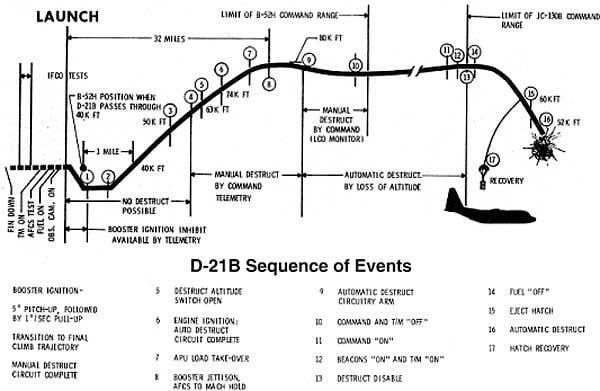
The proposed new project flight profile. Figure Testpilot.ru
Attachments to connect with the accelerator appeared on the bottom surface of the updated drone. For the initial acceleration, it was proposed to use an additional device equipped with a liquid-propellant rocket engine (according to other data, solid propellant). The booster had a cylindrical body with a conical head. On the side surface of the hull there were several bulges and protrusions necessary for the installation of this or that equipment, as well as for connection with the reconnaissance apparatus. A small trapezoid crest-keel was located under the tail part of the hull. The accelerator was 13,5 m long and weighed over 6 t.
In the nose of the accelerator was located instrument compartment with a set of equipment to start the main engine of the UAV. Immediately on the nose fairing was placed impeller, under the pressure of air driving the generator and pumps of the hydraulic system. It was proposed to use electric power and pressure in the systems for launching the main devices of the D-21B apparatus before its output into independent flight.
After uncoupling from the carrier, the bundle in the form of a drone and accelerator had to plan for a few seconds and move away from the aircraft. After that, the accelerator was started, which, during 90 from work, accelerated the device to a speed of M = 3 and raised it to a height of about 22 km. There, the spent accelerator was dumped, after which the D-21B was supposed to begin an independent mission to the target.
In mid-December 1966, the air force, which was still the customer for the development of the project, was handed over to Lockheed the B-52H bomber (60-0036 serial number), which would soon be the carrier of an unmanned reconnaissance aircraft. Soon the second aircraft with the number 60-0032 was sent to the plant in Pamdale. On the wings of the aircraft, between the fuselage and the central pairs of engines, two pylons were installed with fastenings for transportation of the reconnaissance complex. Mounting means ensured keeping the drone behind the locks on the top of the fuselage. The accelerator, in turn, was hung from the bottom of the device.
28 September 1967, one of the converted bomber took off from the airfield and headed for the D-21B launch point. However, the first flight of the updated device on that day did not take place. On the way to the point of discharge, the pylon mountings broke, due to which the experimental apparatus No. XXUMX broke and crashed. K. Johnson noted that this incident had confused the team of the Skunk Works department.
On November 6, the carrier aircraft was able to deliver the prototype model 507 to the starting point and reset it there. Further, all the systems worked normally, so that the prototype of the intelligence officer was able to fly 250 km. 2 December of the same year, item # 509 set a kind of record, flying 2650 km. The next two launches, made on January 19 and April 10 on 68, ended with the flight of vehicles at a distance of no more than 520 km.
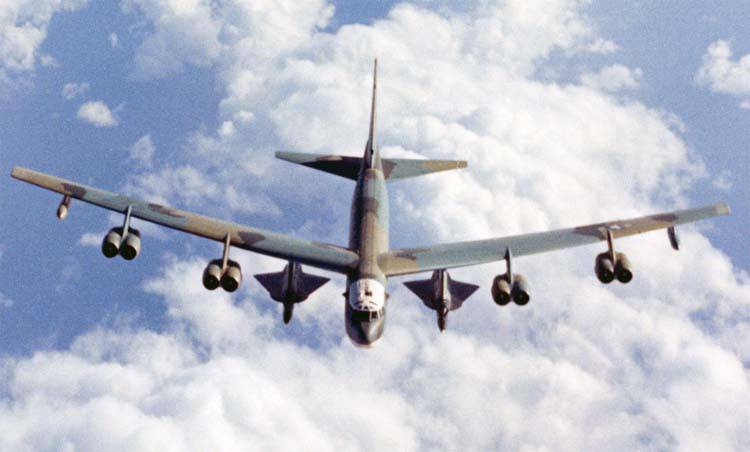
Modified B-52H with two unmanned reconnaissance aircraft under the wing. Photo Airwar.ru
According to some reports, it was soon decided to start full-scale inspections with imitation of real intelligence work. The device was supposed to take photographs of a specified area, and then drop the container with the equipment and film. During the summer of 1968, three test flights were performed. In the first of these, prototype No. 513 flew 5300 km, took the necessary photos and dropped the container, which was soon picked up. From December 1968 to July 1969, Skunk Works and related organizations conducted four more tests. During these flights, the maximum range reached 5470 km. The systems of “catching” the container container in the air have shown themselves from the good side.
The capabilities of the B-52H bombers made it possible to simultaneously transport up to two unmanned reconnaissance aircraft. During test launches, the carriers did indeed repeatedly take to the air with two D-21B, but each time only one of them was launched. The second, in turn, served as an understudy in case of any problems. However, as far as is known, such a replacement has never been needed.
According to the test results, the reconnaissance complex in the form of a converted bomber, a D-21B drone and an accelerator was found to be suitable for actual operation. The United States Air Force decided to start operating new technology in order to conduct strategic intelligence. By the fall of 1969, the complex was prepared for use in real conditions. The program of application of the newest intelligence officers was called the Senior Bowl. Carriers were supposed to take off from Beale (California) and Andersen (Guam) airbases.
The first full-scale reconnaissance flight of the D-21B took place on November 9 of the year 1969. The purpose of intelligence No. XXUMX was the Chinese nuclear test site Lobnor located in the western part of the country. Separated from the carrier, the drone went to the target area and, apparently, took the necessary photographs. However, after that, there was a certain breakdown of the guidance systems, due to which he did not turn around and did not head back towards the ocean, where aircraft and vessels with equipment to catch the hardware container were waiting for him. American experts did not wait for the return of the intelligence apparatus, because of which he was declared lost.
Later it became known that the D-21B continued to fly and remained in the air until the production of fuel, and then planned to the ground. Soon he was found by Soviet counterintelligence. By coincidence, the drone fell a few hundred kilometers from the Baikonur test site. Such a discovery interested the Soviet specialists who took up its study. It is believed that some ideas and solutions, peeped on American technology, were later used in the creation of Soviet aircraft of similar purpose.
According to the results of the first “combat” launch, it was decided to conduct additional tests. 20 February The 1970 serial number 521, which underwent some improvements, successfully flew about 5400 km, took a photo of a conditional target and dropped the container in a predetermined area where it was caught by the JC-130B aircraft pilots. According to the results of these tests, it was decided to continue the military operation of equipment, which, however, should be updated according to the latest version of the project.
16 December of the same year the second launch took place as part of Operation Senior Bowl. The device number XXUMX sent to shoot Chinese secret objects. Having flown about 523 km, the device dropped the container and self-destructed. After dumping the container could not open the parachute, because of which the pilots of the specially equipped aircraft did not catch it. Soon the container fell into the Pacific Ocean and drowned, taking with it all the collected intelligence information.
4 March 1971, the third scout flight of the D-21B scored a success. Overcoming a route longer than 5430 km, apparatus No.526 dropped the container with the equipment and images of the Lobnor polygon in a given region of the Pacific Ocean. The plane on duty there again could not catch the container, letting it fall into the water. The crew approached the ship did not cope with the "catch" on the first attempt. Performing a maneuver for a new approach, the ship damaged the container, because of which he went to the bottom.
The last flight of the D-21B took place on 20 in March of the same year. The device number XXUMX did not return from the flight, and his fate remained secret for a long time. The military and the designers considered that the reconnaissance equipment was malfunctioning or was hit by Chinese air defense units. A few decades later, it became known that the drone without someone else's "help" fell in Yunnan province, where it was later found. For some time, the wreckage of unique technology lay idle at one of the sites of the Chinese Aviation Museum (Beijing), from where they were transferred to the exposition in 527. Now there is demonstrated a large section of the fuselage and the keel wing. For obvious reasons, this exhibit is not the best state.
In the 1969-71 years, the US Air Force performed four launches of D-21B reconnaissance drones. None of them ended in taking pictures. In two cases, the devices for one reason or another did not return from the task, and in the other two there were serious problems with the return of the container. At the same time, the equipment was quite expensive. According to reports, the construction and use of a single unit cost about 5,5 million dollars in 1970 prices of the year (slightly less than 35 million by modern standards). Similar results forced to doubt the expediency of further operation of the equipment. After some disputes and discussions, a final decision was made, which put an end to stories interesting project.
23 July 1971, the program D-21B was officially closed due to the lack of real results and the presence of a lot of unsolvable problems. In addition, by this time, the United States had created a fairly large grouping of intelligence satellites, which differed from the drone more efficient operation. The equipment of new types built and transferred to the customer was written off. Bombers carriers were converted to the original project and returned to the appropriate units.
Within the D-21A and D-21B projects, Lockheed built 38 prototypes. The 21 product was used in tests and during military service. The remaining 17 drones were out of work. First, they were sent for storage at the Norton base (pieces of California), from where they were later transported to the “dump” of the Davis-Monten base (pieces of Arizona). Storage areas for decommissioned aircraft equipment are not protected from prying eyes, due to which aviation enthusiasts soon noticed “new items”. After this, the most interesting development of the Skunk Works department became widely known.
Interestingly, in some materials, starting from the seventies, reconnaissance drones are designated as GTD-21B. For some reason, letters have been added to the original name of the vehicle, meaning Ground Training - “ground training”. Probably, in this way, the air force tried to hide the true purpose of the decommissioned vehicles. However, further disclosure of information and the emergence of new, more complete information made such masking unnecessary.
Later, drones, which were no longer needed, were distributed among US aviation museums. Currently, the exhibition of several museums has about a dozen of such exhibition samples. Eight vehicles, presented in museums, belong to the modification with the letter “B”. As for the first modification of the technology, the sample located in Seattle is mounted on the only remaining carrier aircraft, M-21.
Initially, the goal of the designers of the Skunk Works department, led by Kelly Johnson, was to create a promising unmanned reconnaissance vehicle capable of replacing manned aircraft and reducing the risks to personnel. Through the use of certain materials and some bold ideas, engineers managed to create the required technique. However, the lack of certain technologies and the difficulty of finding a replacement for them led to not the best result. Until the very end of the testing and operation of the D-21 family, the problem was in the form of difficulties in returning the container with the equipment and the results of the photography. It was not possible to resolve this issue. Such problems in combination with the complexity and high cost of technology led to the abandonment of an interesting and unusual development.
Based on:
http://testpilot.ru/
http://airwar.ru/
http://globalsecurity.org/
http://designation-systems.net/
http://airforceworld.com/
http://wvi.com/
Nikolsky M.V. Black Lightning SR-71. - M .: “Astrel Publishing House”, “AST Publishing House”, 2001. - (Famous aircraft).
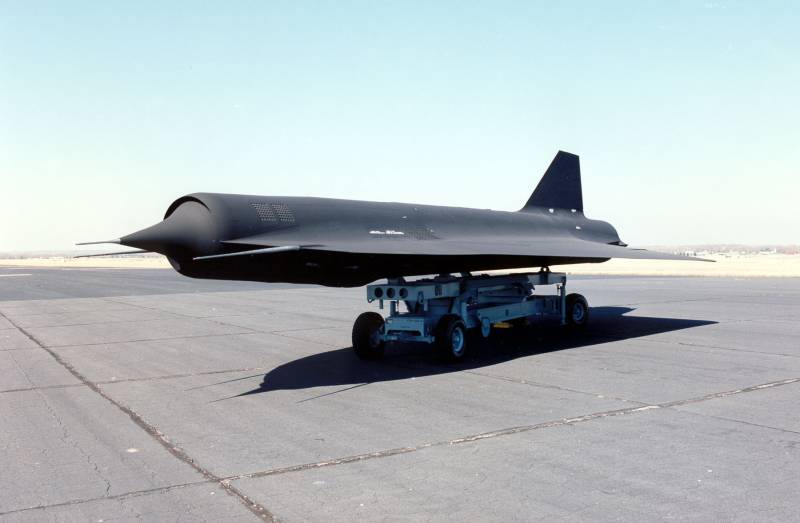
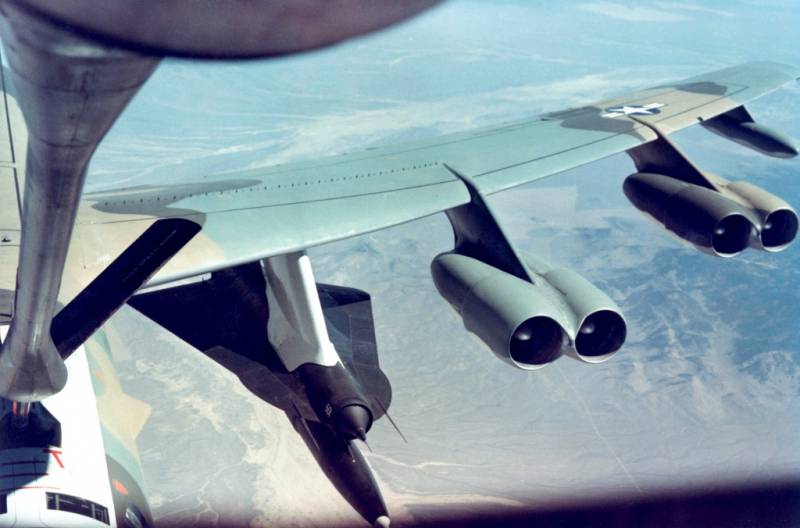
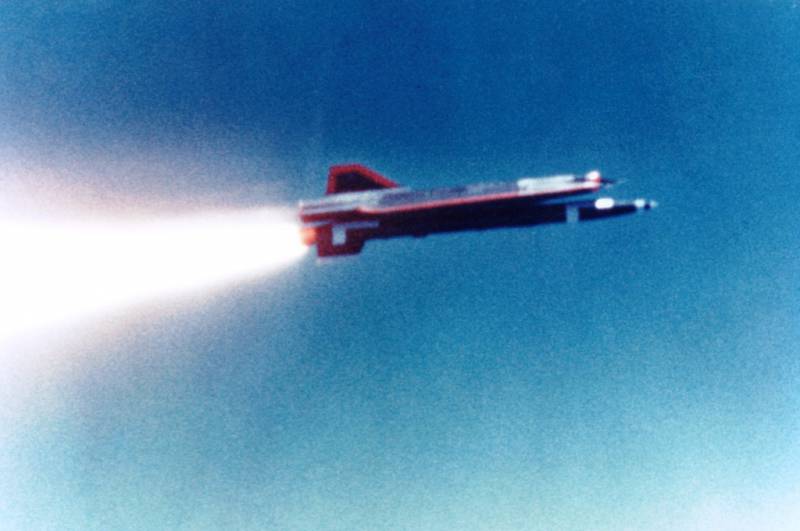
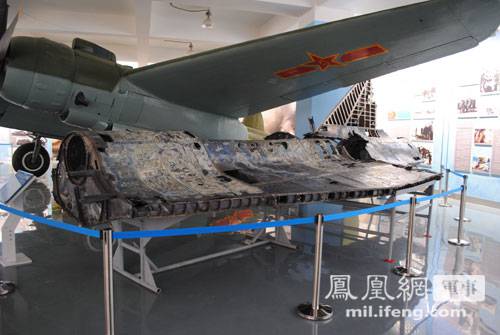
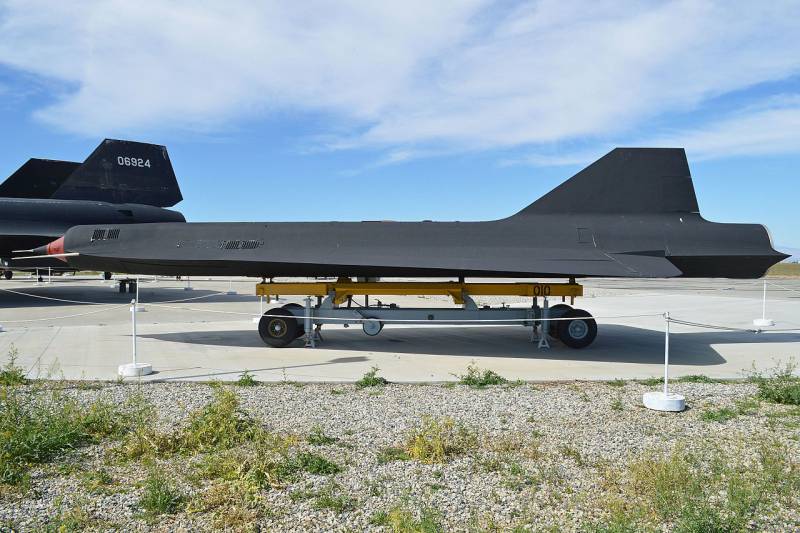
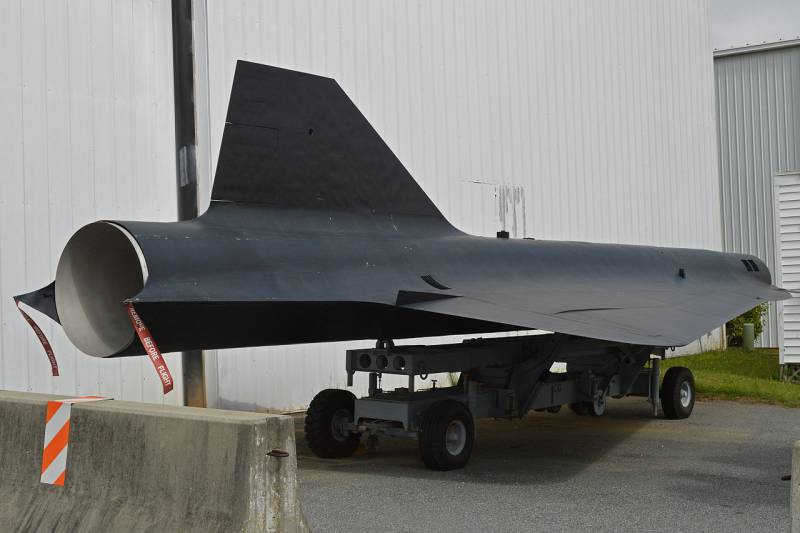
Information